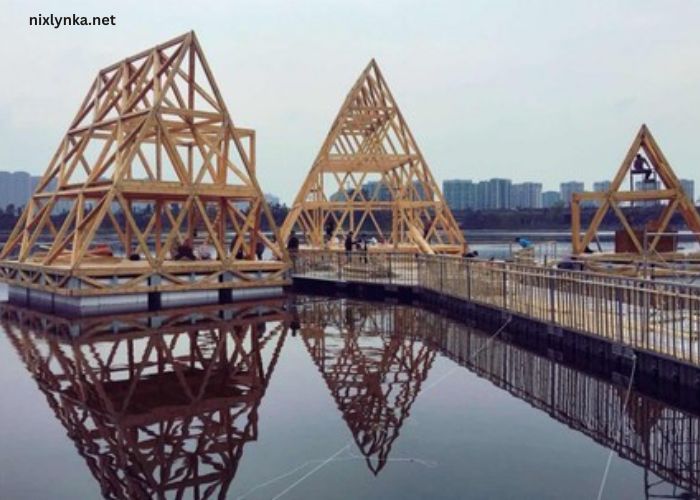The Makoko Floating School has been a symbol of innovation, creativity, and sustainability in architecture and urban design. It started as a solution to the challenges faced by the residents of Makoko, a slum area in Lagos, Nigeria, that is prone to flooding.
Over time, the project evolved, becoming more refined and functional. The latest iteration, IIIX3, represents the fourth prototype of the Makoko Floating School and is an exciting new chapter in its journey. This new design showcases how sustainable architecture can be used to improve communities, especially in vulnerable areas.
Key Points:
- IIIX3 is the fourth prototype of the Makoko Floating School.
- It is designed with sustainability and resilience in mind.
- This model continues the legacy of using innovative architecture to solve real-world problems.
What Is the Makoko Floating School, and Why Was It Created?
The Makoko Floating School was conceived to address a specific set of challenges faced by residents of the Makoko community. Located in Lagos, Nigeria, Makoko is built on stilts in a lagoon, making it vulnerable to flooding and natural disasters. Due to the lack of traditional infrastructure, many children in this community were unable to attend proper schools.
Kunlé Adeyemi, the visionary behind the project, designed the original floating school as a sustainable solution to these problems. The first prototype, completed in 2013, was a floating structure made primarily of wood, designed to withstand the harsh water conditions while providing a safe space for education. It was an innovative solution to the lack of land-based infrastructure, offering a model for how to design buildings in vulnerable, water-based environments.
The success of the first prototype led to the development of new versions that improved upon the original design. IIIX3 is the fourth iteration and builds upon previous lessons learned from earlier prototypes. It is not just a school—it’s a comprehensive educational facility designed to stand the test of time, while also adapting to the unique needs of the community it serves.
How Does IIIX3 Improve Upon Previous Prototypes?
With each new iteration of the Makoko Floating School, there have been improvements in both design and functionality. IIIX3 is no exception. Here’s how it takes things to the next level:
1. Sustainability and Materials
The IIIX3 prototype focuses on using more durable and sustainable materials than the earlier versions. For example, it incorporates eco-friendly materials that are resistant to both water and weather conditions, ensuring the building’s longevity. Previous prototypes used mostly wood, but IIIX3 includes other materials like steel and concrete to enhance its durability and safety. These materials also help minimize maintenance costs, ensuring that the school can continue to operate effectively in the long term.
2. Enhanced Structural Resilience
In comparison to the first and second prototypes, which had a more simplistic design, IIIX3 is built with a more robust and resilient structure. The floating foundation, for example, has been designed to withstand stronger currents and higher water levels, which are common issues in the Makoko area. The design also includes reinforced platforms and roofs that can better protect against storms and extreme weather.
3. More Functional Spaces
One of the key changes in IIIX3 is its improved layout. The previous prototypes were designed mainly with basic educational needs in mind, but IIIX3 offers a more versatile space. It includes not just classrooms but also facilities for community gatherings, workshops, and recreational activities. The idea is to create a space that serves multiple functions, ensuring that it is not just used for education but also contributes to the social and cultural development of the community.
| Prototype | Materials Used | Main Features | Resilience to Weather |
| Prototype I | Wood | Basic structure for education | Low |
| Prototype II | Wood, Steel | Improved design for classrooms | Moderate |
| IIIX3 | Steel, Concrete | Versatile spaces for education and community | High |
Note: IIIX3 provides greater space flexibility, accommodating both educational and community needs.
What Are the Environmental Benefits of IIIX3?
Another key feature of the IIIX3 prototype is its emphasis on sustainability and the environment. The use of eco-friendly materials ensures that the school is not just resilient to environmental challenges, but also has a minimal impact on the environment. Here are some of the ways that IIIX3 contributes to environmental sustainability:
- Water-Based Design
The floating school design helps to preserve the land around Makoko by utilizing water for the building’s foundation. This minimizes the impact of construction on the surrounding environment and helps maintain natural habitats. - Solar Energy
IIIX3 incorporates solar panels on its rooftop, providing clean energy to power the school. This reduces the school’s reliance on local grids, which can be unstable, and ensures that the school operates sustainably. - Rainwater Harvesting
The design includes rainwater harvesting systems that allow the school to collect and store rainwater, which can be used for various purposes, such as irrigation or sanitation. This helps reduce the community’s dependence on external water sources, especially in times of drought or water shortages.
| Environmental Feature | Impact |
| Water-Based Foundation | Preserves land and reduces environmental disruption |
| Solar Panels | Reduces reliance on external electricity grids |
| Rainwater Harvesting | Provides a sustainable water source for the school |
How Will IIIX3 Benefit the Makoko Community?
The Makoko Floating School’s goal is not just to provide education but to enhance the overall well-being of the community. IIIX3 takes this mission further by offering a multifunctional space that will benefit the residents in various ways:
- Educational Opportunities
The primary benefit of the floating school is that it provides a safe and stable place for children in the community to receive an education. With access to proper learning spaces, children in Makoko can break the cycle of poverty and build better futures for themselves. - Community Hub
The design of IIIX3 allows it to serve as a community hub, where people can come together for social events, workshops, and cultural activities. This helps foster a sense of community and belonging among residents. - Job Creation
The construction and operation of IIIX3 will provide local job opportunities, from builders to teachers to maintenance staff. This will help boost the local economy and offer sustainable employment for community members.
Conclusion
The IIIX3 prototype of the Makoko Floating School is a significant leap forward in addressing the challenges faced by the Makoko community. With its innovative design, sustainability focus, and multifunctional spaces, this project is helping to shape the future of education and community development in water-bound urban areas. It showcases how architecture can be used to solve real-world problems while promoting environmental sustainability.
FAQ’s
- What makes IIIX3 different from previous Makoko Floating School prototypes?
IIIX3 is more resilient, incorporates eco-friendly materials, and offers versatile spaces for both educational and community purposes. - How does IIIX3 address environmental concerns?
IIIX3 uses sustainable materials, solar energy, and rainwater harvesting to minimize its environmental impact. - What is the main purpose of the Makoko Floating School?
The main purpose is to provide safe, accessible education in a community that lacks adequate infrastructure. - How will the Makoko Floating School benefit the Makoko community?
It will offer educational opportunities, serve as a community hub, and create local job opportunities. - Can I visit the Makoko Floating School?
Visiting the Makoko Floating School may require special arrangements, but the school aims to engage with the community and share its innovative approach.





